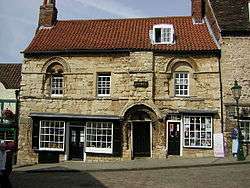Jew's House
The Jew's House is one of the earliest extant town houses in England. It is situated on Steep Hill in Lincoln, immediately below Jew's Court.[1] The house has traditionally been associated with the thriving Jewish community in Medieval Lincoln. Antisemitic hysteria was stoked by a notorious 1255 blood libel alleging the murder that a child, called Little Saint Hugh of Lincoln, was ritually killed by Jews. In 1290, the entire Jewish community was expelled from England, and the Jew's House is said to have been seized from a Jewish owner. The building has remained continuously occupied to the present day. Since about 1973 it has been used as a restaurant; before that it was an antiques shop.
| Jew's House, Lincoln | |
|---|---|
 Frontage of the Jew's House, Lincoln | |
| Location | At the junction of Steep Hill and the Strait, between Uphill and Downhilll, Lincoln |
| Coordinates | 53.2322°N 0.5388°W |
| OS grid reference | SK9763371566 |
| Built | Later 12th Century |
| Architectural style(s) | Romanesque Town House |
Listed Building – Grade I | |
| Designated | 8 October 1953 |
| Reference no. | 486271 |
 Location in Lincolnshire | |
Architecture
The Jew’s House is built in the local limestone in the Norman or Romanesque style. Dating from the mid-twelfth century, the building originally consisted of a hall at first floor level, measuring approximately 12 by 6 metres, above service and storage spaces at ground level.
Part of the façade survives; the elaborately carved doorway, the remains of two Romanesque double-arch windows and much of the stonework on the upper storey. A chimney breast rises over the arch above the front door, serving the fireplace on the upper floor. There were once two columns supporting the arch, but these have gone.[2]
See also
- Norman House
- Whitefriars, 333 High Street, Lincoln
- John of Gaunt's Palace, Lincoln
- St. Mary's Guildhall, Lincoln
References
- Historic England. "Monument No. 326716". PastScape. Retrieved 19 February 2011.
- ”Antram’’ (1989), pg 519
Literature
- Anon. (1983) Norman Buildings in Lincoln, Lincolnshire Museums Information Sheet, Archaeology Series 26.
- Antram N (revised), Pevsner N & Harris J, (1989), The Buildings of England: Lincolnshire, Yale University Press. pg 525.
- M. E. Wood (1974), Revised ed. Norman Domestic Architecture.
External links

- British Listed Buildings
- 1911 Encyclopædia Britannica
- mondes-normands.caen.fr
- http://www.jewshouserestaurant.co.uk/
.png)